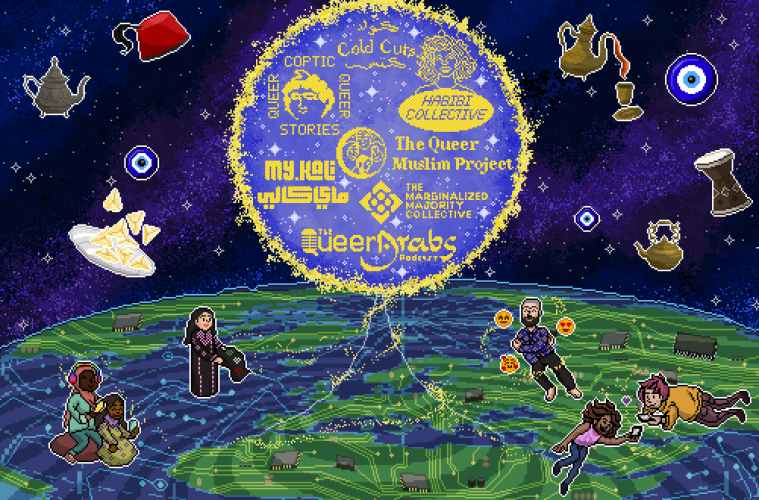Interview by Aryana Ghazi Hessami
Artwork by Mloukhiyyé
This article is part of the “Hopefully Tomorrow” issue
The future is unchartered territory; we look to it with hope in the belief that we might repair the wrongdoings of our past and present. Since the birth of the public internet in the 1980s, our dreams of the future have been dominated by the potentials of digital technologies. Today, our bodies are governed and shaped by the digital in ways that can both emancipate and shackle us. As our social and technological worlds continue to blend into each other, we have become increasingly reliant on technology to perform labor, maintain kinship relations, and convene in what queer theorist Lauren Berlant terms as “intimate publics,”1 a community characterized as sharing a worldview and emotional knowledge that have derived from broadly common historical experience.
The digital realm has become a space where queer politics play out, where communities otherwise not able to flourish are mobilized through self-representation and where queer intimate publics are generated. We have to better understand the slippages between our social and technological worlds to find ways to use them to our advantage and actively design our own queer futures. How can we appropriate technology to craft queer intimate publics in digital space that afford equitable futures for all?
Queer, here, refers to a worldmaking practice in which queerness is considered not just as non-normative sexual practices, desires, affiliations, and gender embodiments, but also as alternative ways of seeing and being in the world. Attentive to these concerns, I incorporate Berlant’s concept of intimate publics as a shared community of sentiment around queer issues, with Gayatri Gopinath’s notion of a “queer regional imaginary,”2 to specify how new diasporic connections and framings of region can take hold in digital space, without a centralised Euro-American focus. Ultimately, making space for the inclusion of new queer intimate publics. Second, I show what has, and what can, digital space continue(s) to afford in designing queer intimate publics.
In the SWANA context, it is important that the digital affords the potential to create diasporic connections and imaginaries in new ways that support the flourishing of queer lives in alternative sexual geographies beyond a Euro-American frame. Gopinath’s concept of a “queer regional imaginary,” suggests “a possibility of tracing the lines of connection and commonality… between seemingly discrete regional spaces… to produce a new mapping of space and sexuality”3, which can help us imagine what a queer intimate publics in digital space might look like. A queer regional imaginary offers a way to understand the SWANA region as “stand[ing] in contradistinction to dominant national imaginary that effaces nonconforming bodies, desires, and affiliations”.4
digital spaces have not always been safe for queer folx, nor can the internet ever be free of it’s capitalist origins; social media platforms, while emancipatory, remain places of capitalist marketing and exploitation.
Building on this, we can imagine digital space as a site that bypasses national (and historically colonialist) borders to enable travel, communication, and connection across lands, establishing new intimate publics formed around the locus of non-normative sexualities and desires. A digital queer regional imaginary, then, offers the freedom to craft new social bonds unencumbered by obstacles of physical geography and recreate their own conception of space and temporality breaking from dominant normative constructions of sex, nation-state, and region. Importantly, the intimate publics of the queer regional imaginary push against dominant Euro-American articulations of queerness and define their sexuality on their own terms, from/within their own historical and cultural contexts across, and beyond, SWANA. Our digital queer futures must take into account a queer regional imaginary to “reanimate the concept of the region by understanding it as a relational category, shifting and mobile, rather than fixed or static”5 to make sure our online futures are safe, inclusive, and equitable for all.
There are many examples of how the digital realm offers a space of experimentation and exploration of queer identity and worldmaking. Róisín Tapponi’s Habibi Collective, an online curatorial platform for filmmaking that showcases the work of women and non-binary folk of SWANA descent, is an example of how intimate publics can use art to map new cartographies of sexuality that critique, subordinate, and bypass the nation-state and governance of bodies and sexualities therein, in digital space. Additionally, online magazines (Queer Coptic Stories, My.Kali, Cold Cuts), applications like Instagram (@TheQueerMuslimProject @voices4_ @themarginalizedmajority) and TikTok (@thetransmuslim, @mrspotatoqueen), and podcasts (@thequeerarabs) provide a platform for intimate discovery of unbound sexualities. This is especially salient in places where state (and family) stigmas sanction binary gendered identities and render transgressive sexuality taboo. As these examples show, not only is digital space a place for experimentation and expression, but also a space for education, to learn about the realities of living otherwise, outside of normative traditions, giving one the confidence to live one’s truth. Online representation has allowed marginalized communities to explore themselves, find each other, and form connections beyond the internet carrying these intimate publics into our offline worlds.

Artwork by Mloukhiyyé
However, digital spaces have not always been safe for queer folx6, nor can the internet ever be free of its capitalist origins; social media platforms, while emancipatory, remain places of capitalist marketing and exploitation7. Moreover, one has to navigate racist, sexist algorithms and patriarchal censorship8, as well as the consequences of being out online. Many queer people in digital space, especially queer people of faith, are not out online or off, even in places like the UK9. As London Queer Muslims notes, “queer Muslims [are] excluded from heteronormative Muslim spaces and simultaneously excluded from homonormative “LGBT” spaces. Both spaces have become equally structured in order to position queer Muslims in an unwarranted state of debate as a condition for involvement”10. Being out as a queer and a person of faith is often dangerous and can end in ostracization, or violence.
Despite the potential backlash, we must continue to use digital space as a tool to navigate patriarchy and capitalism, to demand social justice, and to allow queer intimate publics to take form. Areeq Chowdhury, director of WebRoots Democracy explains, “by enabling people to have a platform to speak, under a pseudonym if necessary, [the digital realm] has created a space for individuals to share experiences, make friends and gain role models.”11 Digital spaces have afforded a portrayal of lived queer experiences that may be otherwise hidden from our everyday publics. Queer Coptic Stories, for example, uses the digital realm to enact its “mission to share and preserve our stories, create a meeting space for queers, & broaden the notion of Coptic identity”12. Queer intimate publics in digital space affirm “We are here, and we exist.”
Looking beyond the digital as an isolated entity, we can see that queer intimate publics in digital space feed back into how sexuality is addressed in everyday life offline. Likewise, queer experience in offline public spaces can help us understand how to better design queer futures online. What does public space really offer? Who is it for? What does it lack? The formation of queer intimate publics in digital space redefines a ‘public’ and defines its own boundaries of inclusion outside of capitalism or patriarchy. Additionally, it affords discovery and communication with a community of shared experience one might not have otherwise found, in order to support and help each other, paving the way for increasing queer visibility across SWANA and beyond. We must continue to use the digital realm as a place to tell our stories and lived experiences, construct our identities, and act with a desire to have our voices recognised in public debates around sexual identity. In telling our stories in digital space, we create our own intimate publics through a queer regional imaginary that pushes the boundaries of belonging and inclusion to establish a more inclusive equitable space without the need to masquerade or live along the margins. Our stories are worthy of taking up, and crafting our own, queer intimate public space on and offline. These new publics, grounded in shared collective experience, learned from each other in our online and everyday worlds, offer collectively witnessed survival as a ground for our ‘hopefully tomorrow’ future social relations.
- Lauren Berlant, The Female Complaint (Durham: Duke University Press, 2018)
- Gayatri Gopinath, Unruly Visions (Durham: Duke University Press, 2018)
- Ibid, 5.
- Ibid, 5.
- Ibid, 21.
- Folx is a gender-neutral collective noun used to address a group of people. Unlike the term “folks”, the ending “-x” on “folx” specifically includes LGBTQ people and those who do not identify within the gender binary.
- Legacy Russel, Glitch Feminism (London: Verso, 2020).
- Safiya Umoja Noble, Algorithms of Oppression How Search Engines Reinforce Racism (New York: NYU Press, 2018).
- “LGBT in Britain — Home and Communities,” Stonewall, https://www.stonewall.org.uk/lgbt-britain-home-and-communities.
- “About,” London Queer Muslims, https://londonqueermuslims.com/.
- Diyora Shadijanova. “In Queer Muslims Are Carving Out Their Space On TikTok,” Refinery29, August 6, 2020, https://www.refinery29.com/en-gb/2020/08/9929540/queer-muslim-tiktok.
- “Interviews,” Queer Coptic Stories, https://www.copticqueerstories.com.

